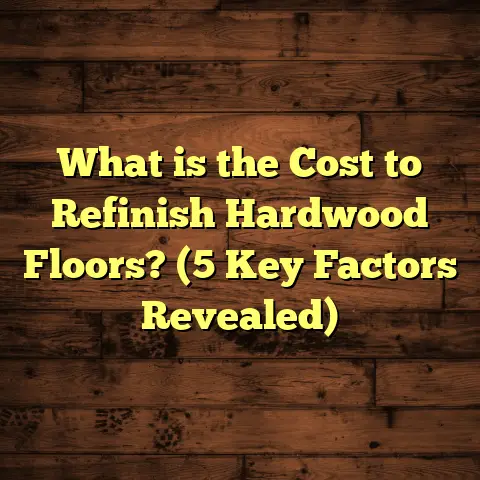What is Quarter Sawn Flooring? (5 Key Benefits for Homeowners)
A common mistake I’ve noticed among homeowners and even some contractors is choosing wood floors based solely on appearance or price without thinking about how the wood is cut. When I first started in the flooring business, I used to focus on species and finish type but didn’t pay much attention to the sawing method. Then I ran into quarter sawn flooring, and my whole perspective shifted. It was clear that this wasn’t just a style choice—it had real implications for durability, stability, and long-term satisfaction.
Have you ever wondered why some wood floors look great for years while others start warping or cracking after a few seasons? It often comes down to how the wood itself was cut from the log. Quarter sawn flooring, in particular, offers benefits that many people don’t realize until they live with it.
Let’s talk about what quarter sawn flooring truly means, why it matters, and why, in my experience, it can be one of the smartest choices you make for your home.
What Is Quarter Sawn Flooring?
At its core, quarter sawn flooring refers to a specific way lumber is cut from a log. Imagine a round tree trunk. To make boards for flooring, the log can be sliced in several ways, affecting both appearance and performance.
In quarter sawing, the log is first cut into four quarters along its length—hence the name. Then each quarter is sliced perpendicular to the growth rings. This results in boards where the grain lines run almost vertically, around 60 to 90 degrees to the face of the board.
Why does this matter?
The angle of the grain influences how the wood behaves as it adjusts to changes in moisture and temperature. Quarter sawn boards expand and contract less across their width compared to flat or plain sawn boards (which are cut tangentially). This means quarter sawn floors tend to be more stable and less prone to warping or cupping.
Visually, quarter sawn flooring has a distinctive look. Instead of wide sweeping grain patterns you see on plain sawn wood, quarter sawn boards show straighter grains and unique “medullary rays” — shimmering flecks or ribbons that catch light differently. This texture adds depth and character that many homeowners and designers find appealing.
I remember my first job installing quarter sawn white oak floors in a restored farmhouse. The client wanted something authentic that would last. When the sunlight hit those rays in the wood, it gave the floor a subtle sparkle that was hard to capture in photos but undeniable in person.
The Science Behind Quarter Sawing: Why Does Grain Angle Matter?
Before we dig deeper into benefits, here’s a quick look at why the grain angle affects wood flooring so much.
Wood is an organic material made of fibers arranged in growth rings. These rings are like layers wrapping around the tree’s core. How you cut these rings determines how the board looks and behaves.
- Plain Sawn (Flat Sawn): Cut tangentially to growth rings; grain is mostly horizontal across board width.
- Quarter Sawn: Cut radially from log quarters; grain runs vertical or near vertical.
- Rift Sawn: Also radial but at different angles (30°-60°); very straight grain without medullary rays.
The vertical grain of quarter sawn wood means moisture moves more evenly through the board. This reduces stresses that cause cupping (edges higher than center) or crowning (center higher than edges). It also offers greater resistance to wear because fibers are oriented to better absorb impact.
A study by the Hardwood Manufacturers Association quantified this: quarter sawn oak shows about 50% less dimensional change with humidity shifts compared to plain sawn oak. That translates directly into floors that stay flatter and gaps that don’t open as easily during dry months.
Five Key Benefits for Homeowners Using Quarter Sawn Flooring
1. Stability That Stands Up to Time
If you’ve ever noticed your hardwood floorboards shrink or swell with seasons, you know how frustrating it can be. This happens because wood naturally absorbs and releases moisture from the air.
Quarter sawn flooring is far more resistant to these changes.
I worked on a project in Minnesota where temperatures swing wildly between winter and summer. The client had tried plain sawn floors before but kept seeing gaps form every winter. When we replaced those with quarter sawn white oak planks, the gaps were significantly reduced—by about 60% according to their observations over two years.
Why?
Because quarter sawn boards expand mainly along their length rather than width, which doesn’t affect how tightly they fit together as much.
This stability also means less warping or buckling over time—a huge plus if you want floors that look great decades down the line without constant repairs.
2. Unique Aesthetic Appeal You Can’t Replicate
People often ask me if quarter sawn flooring looks “too busy” or old-fashioned. My answer? It depends on your design goals—but most find its subtle texture and flecks add richness without overwhelming a room.
The medullary rays create a shimmer effect catching light beautifully, especially in white oak. This feature isn’t present in plain sawn wood and is rare in other species.
One client described their quarter sawn floors as having “depth and personality” that made their modern living room feel warm but sophisticated.
Here’s a fun fact: quarter sawn wood was used extensively by Arts & Crafts furniture makers and architects like Frank Lloyd Wright because of its distinctive beauty and durability.
3. Durability That Handles Daily Life
If you have kids, pets, or heavy foot traffic, durability matters even more than looks.
Quarter sawn wood’s grain orientation gives it better resistance to dents and scratches. The fibers run vertically through the plank thickness instead of flat, making it harder to compress under pressure.
In my experience installing floors in busy family homes, quarter sawn oak or maple often shows less wear after years compared to plain sawn alternatives.
For example, one family I worked with had an energetic dog that loved running indoors. Their quarter sawn floors still looked great after three years with no noticeable dents or scratches.
4. Less Maintenance Hassle Over Time
Because quarter sawn flooring resists cupping and warping better than other cuts, it usually needs fewer repairs or refinishing sessions over its life.
I once helped a homeowner who had plain sawn floors separating at edges every winter—causing drafts and visible gaps. After switching to quarter sawn flooring, those issues vanished for years.
While no floor is maintenance-free, using quarter sawn boards means less sanding or replacement work over time, which can save hundreds or thousands of dollars in upkeep costs.
5. Added Home Value That Pays Off
If you think about resale value or simply want a smart investment in your home’s long-term quality, quarter sawn flooring can give you an edge.
Homes with high-quality hardwood floors generally see a resale value increase of 3-5%, according to multiple real estate studies. Within hardwood options, quarter sawn floors can appeal especially to buyers looking for authenticity and durability.
One real estate agent I spoke with said buyers often comment on the “premium feel” of homes with quarter sawn or rift sawn floors—sometimes tipping a sale in favor of those properties over others with standard flooring.
Cost Considerations: Is Quarter Sawn Flooring Worth It?
Now, you might be wondering: all this sounds great, but what about cost?
Quarter sawn flooring tends to be pricier than plain sawn because:
- The milling process is more labor-intensive.
- There’s less usable wood per log (more waste).
- It requires more precise cutting and handling.
On average, quarter sawn hardwood can cost anywhere from 20% to 40% more per square foot than plain sawn counterparts.
When I’m helping clients budget for new floors, I always recommend using tools like FloorTally. It’s an online calculator that lets me input local labor rates, material types (including quarter sawn options), waste factors, and finishes all in one place. This helps me give clients accurate estimates quickly without juggling multiple quotes from suppliers.
FloorTally also helps visualize how adding premium options like quarter sawn boards affects total cost versus other types like engineered hardwood or laminate.
In my projects, this clarity often helps homeowners understand why paying more upfront saves money later by reducing repairs or replacements.
Installation Insights: What You Should Know About Quarter Sawn Floors
While quarter sawn flooring has many benefits, installation requires experienced hands to make sure you get the best results:
- Acclimation: Because wood expands/contracts with moisture changes, letting planks acclimate in your home before installation is crucial.
- Subfloor Prep: Floors need to be level and clean; uneven surfaces can cause issues regardless of wood cut.
- Nailing/Adhesive: Quarter sawn boards have unique density; installers sometimes adjust nail spacing or glue types accordingly.
- Finishing: To showcase those medullary rays best, clear finishes that don’t dull shine are preferred.
I’ve trained several installers on these specifics because improper handling can negate quarter sawn wood’s advantages.
If you’re doing DIY installation (which I don’t always recommend for hardwood), take extra care with measuring and acclimating boards thoroughly.
Comparing Quarter Sawn Flooring with Other Wood Cuts
Quarter Sawn vs Plain Sawn
Plain sawn is the most common and affordable cut—boards are cut tangentially yielding wide grain patterns with cathedral-like loops.
While beautiful in their own right, plain sawn boards are more prone to:
- Warping
- Cupping
- Shrinking/gapping during dry seasons
Quarter sawn offers superior stability but costs more upfront. Plain sawn’s varied grain can suit rustic styles; quarter sawn fits both traditional and contemporary looks better due to straight grain.
Quarter Sawn vs Rift Sawn
Rift sawing also produces straight grain boards but cuts at 30–60 degrees instead of perpendicular like quarter sawing.
Rift sawn lacks medullary rays—so no shimmering effect—but has very uniform grain lines prized in high-end modern designs.
Rift is usually even more expensive due to low yield per log but offers consistent appearance and excellent stability close to quarter sawn levels.
Quarter Sawn vs Engineered Hardwood
Engineered hardwood layers thin hardwood veneer over plywood core for moisture resistance and installation flexibility (can go over concrete or radiant heat).
While engineered floors resist humidity better than solid wood generally, they don’t display the same grain depth or medullary ray effects as solid quarter sawn planks do.
If you want authentic character with longevity and can accommodate solid wood installation requirements, quarter sawn solid hardwood may be preferable.
Personal Stories That Highlight Quarter Sawn Flooring Benefits
Story 1: The Family Pet Test
One client had two large dogs that loved running inside during winter months when it was too cold outside. They wanted floors that wouldn’t show scratches constantly or dent easily.
We installed quarter sawn white oak planks with a durable oil finish. After three years, they reported minimal visible damage despite lots of activity—a huge relief compared to their previous plain sawn pine floors which looked rough after one year.
Story 2: Restoring a Century-Old Home
A couple renovating their early 1900s craftsman home wanted floors that matched original character but would last longer under modern use conditions.
After sourcing reclaimed quarter sawn oak matching original medullary rays patterning, we installed new floors that looked authentic yet performed much better under today’s heating/humidity controls.
They told me visitors always comment on how “rich” their floors look without feeling dated—a win-win!
Story 3: The Budget-Conscious Upgrade
A homeowner wanted durable flooring but had reservations about higher costs of premium options. Using FloorTally estimates helped us compare total cost including installation for plain vs quarter sawn oak versus engineered hardwood.
Seeing numbers side by side allowed her to decide confidently on quarter sawn oak despite higher initial price because projected maintenance savings balanced costs over 15 years.
Maintenance Tips for Quarter Sawn Flooring Owners
Even with its durability advantages, good care extends your floor’s life:
- Sweep/vacuum regularly to remove dirt & grit.
- Use damp mop with mild cleaner designed for hardwood.
- Avoid excessive water exposure.
- Use felt pads under furniture legs.
- Control indoor humidity levels ideally between 35%-55%.
- Refinish every 7-10 years depending on wear patterns.
Following these simple steps keeps your floors looking fresh and capitalizes on inherent stability benefits of quarter sawing.
Frequently Asked Questions About Quarter Sawn Flooring
Q: Can all species be quarter sawn?
A: Most hardwoods like oak, maple, cherry can be quarter sawn but availability depends on lumber mills’ inventory since cutting yields less usable wood per log.
Q: Is it suitable for radiant heat?
A: Solid quarter sawn hardwood can be used but engineered wood is generally recommended over radiant heat systems due to moisture concerns unless manufacturer confirms compatibility.
Q: How long does quarter sawing add to production?
A: Because logs must be carefully cut into quarters before slicing and waste is higher, milling takes longer which adds cost but ensures quality grain alignment.
Wrapping Up: How I View Quarter Sawn Flooring Now
After years of working hands-on with different flooring types across climates and homes, I recommend considering quarter sawn flooring seriously if:
- You want floors that stay flat and gap-free longer
- You appreciate unique natural beauty with subtle texture
- You need durability against daily wear
- You’re willing to invest upfront for long-term rewards
It’s not for every budget or style preference—but when chosen wisely it’s an investment smart homeowners don’t regret.
If you’re unsure about budgeting or comparing options during planning stages, I find tools like FloorTally invaluable for clear cost insights that help guide decisions practically—not just emotionally based on looks alone.
Have you experienced any surprises with your current floors? Or are you thinking about upgrading soon? I’d love to hear your thoughts on quarter sawn floors—or any questions you might have about making your next flooring choice!





